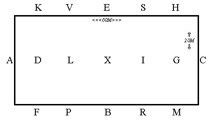Today's guest blogger is Cassie Black, a hobbyist who has shown dressage extensively and trained her own horse through Prix St George:
Basic Dressage for the Model Shower
Dressage is the training of the horse. It is not breed specific and is open to all horses and mules. This training is judged based on a series of movements within a test. Horses are shown at different levels based on their training, Intro level through 4th level are govererned by the USEF and the International levels, Prix St George, Intermediate I, Intermediate II and Grand Prix are governed by the FEI.
Arena
The Dressage arena is a 60 X 20 meter rectangle with a low fence. The Letters around the rail are A-K-V-E-S-H-C-M-R-B-P-F, G-I-X-L-D are not letters on the rail, they are considered invisible letters, and if they are seen they are small under the main rail letters.
Tack
Horses may be shown in any English saddle. The saddle must have stirrups and can be shown with or without a saddle pad (square pads are generally seen.) A Dressage saddle (long flaps) is required for FEI levels.
Bridles for training, first, and second levels must be a plain snaffle with a noseband. A simple double bridle is required for the FEI levels, and is optional for third and fourth level.
Numbers are generally small ovals worn on the side of the browband, just be sure that they are not pinching an ear or covering eyes.
Levels
(revised from USEF rulebook 2009)
These levels are the most important part of showing your model horse in Dressage. The horse should fit into one of these descriptions to do well. Dressage horses should be on the bit, quiet, forward and round over their topline. The models listed after each level are just examples, they can be interchangeable up or down a level and are by no means an exhaustive list.
INTRO LEVEL: A Walk-Trot test for the beginning horse or rider
(Breyer Marigold “Morgan”)
TRAINING LEVEL: To confirm that the horse’s muscles are supple and loose, and that it
moves freely forward in clear and steady rhythm, accepting contact with the bit.
(Peter Stone Pebbles WB, Breyer John Henry)
FIRST LEVEL: To confirm that the horse, in addition to the requirements of Training Level, has
developed thrust (pushing power) and achieved a degree of balance and throughness.
(Top Hat and Tails-Resin)
SECOND LEVEL: Through additional training, the horse accepts more weight on the hindquarters (collection), shows the thrust required at medium paces and is reliably on the bit.
(Utopia-resin, SM Cantering WB)
THIRD LEVEL: The Horse now demonstrates in each movement: rhythm, suppleness, acceptance of the bit, throughness, impulsion, straightness, and collection. There must be a clear distinction between the paces.
(Smittyn-resin, Meridian-resin)
FOURTH LEVEL: The horse has acquired a high degree of suppleness, impulsion, throughness, balance and lightness while always remaining reliably on the bit, and that its movements are straight, energetic and cadenced with the transitions precise and smooth.
(Dinky Duke-resin, Ricardo-resin)
Monday, October 12, 2009
Subscribe to:
Post Comments (Atom)







No comments:
Post a Comment
Moderation is off. Please don't make me turn it on.